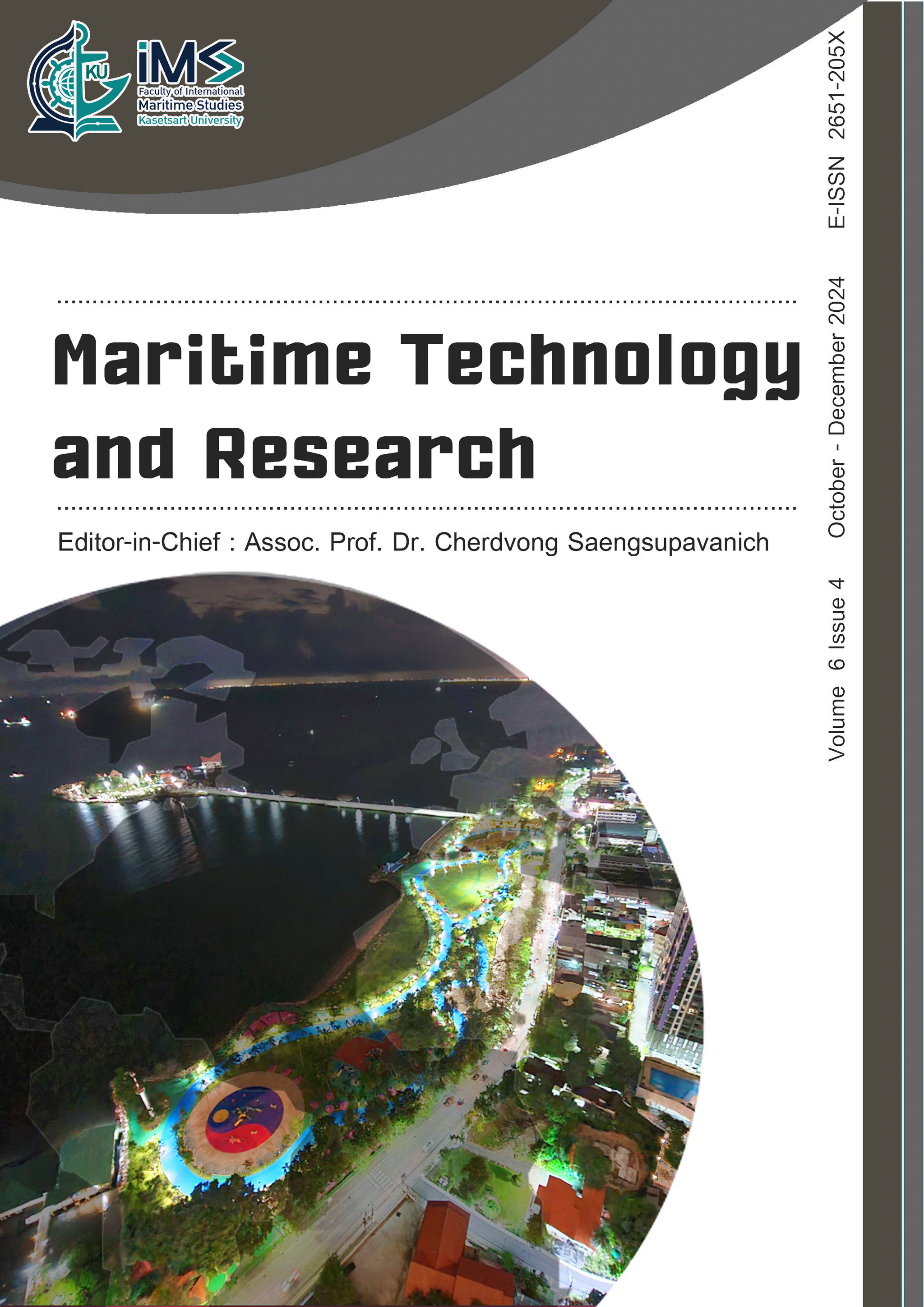An integrated intermodal freight transportation system to avoid container supply chain disruptions in Chattogram Port of Bangladesh
DOI:
https://doi.org/10.33175/mtr.2024.269380Keywords:
Freight transportation, Chattogram port, Lloyd’s List, Port productivity, Quantitative research methodology, Intermodal modelAbstract
An integrated intermodal freight transportation system is a derived demand to transport shipping containers from/to the seaport to/from the hinterland, instead of undertaking cargo loading and unloading activities in port-protected areas. The concept of the intermodal system is to transfer containers to nearby hinterland nodes, such as dry ports, inland rail, road, and river terminals as a part of port development, as well as increasing port efficiency and productivity. Lloyd’s List ranked Chattogram Port as the 67th busiest container port in the world as per container port throughput in 2022. Chattogram Port has small-scale intermodal facilities for off-docks/ICDs in the port city only. In addition, a pure intermodal system has been developed by one rail ICD in the capital city, Dhaka, and two RICTs nearby Dhaka, but less than 5 % of port throughput. A large-scale intermodal for serving the major cities, SEZs, EPZs, and industrial areas is absent due to planning and policy problems, as well as the unavailability of intermodal infrastructure and network. Due to an improper hinterland intermodal chain, the port faced container supply chain disruptions at the port yard and exceeded port capacity, resulting in container vessel congestion at the outer anchorage of Chattogram Port. By developing rail and road infrastructure, and utilizing natural river connectivity, it is possible to develop road, rail, and river intermodal systems, and shape an integrated intermodal freight transportation system to avoid container supply chain disruptions in Chattogram Port. To develop an integrated intermodal system, this research chose a quantitative research methodology for port throughput data analysis and forecasting future throughputs that are advanced to the intermodal model for Chattogram Port. Overall, this paper aims to develop an integrated intermodal freight transportation system to support Chattogram Port to keep and increase the record of port productivity, efficiency, and competitiveness actively.
------------------------------------------------------------------------------
Cite this article: Saha, R.C., Abdus Sabur, H.M., Ruhul Saif, T.Md. (2024). An integrated intermodal freight transportation system to avoid container supply chain disruptions in Chattogram Port of Bangladesh. Maritime Technology and Research, 6(4), 269380. https://doi.org/10.33175/mtr.2024.269380
------------------------------------------------------------------------------
Highlights
- Intermodal system is a derived demand for managing hinterland and port terminals of a seaport that needs to be implemented in Chattogram Port
- Container supply chain disruptions to be avoided to increase the port productivity and efficiency
- Inland intermodal connectivity will help to increase hinterland of a seaport
- It is necessary to develop an integrated intermodal freight transportation system to support Chattogram Port to keep and increase the record of port productivity, efficiency, and competitiveness globally
References
Agamez-Arias, A. D. M., & Moyano-Fuentes, J. (2017). Intermodal transport in freight distribution: A literature review. International Journal of Physical Distribution & Logistics Management, 47(10), 957-983.
Agbo, A. A., Li, W., Atombo, C., Lodewijks, G., & Zheng, L. (2017). Feasibility study for the introduction of synchromodal freight transportation concept. Cogent Engineering, 4(1), 1305649. https://doi.org/10.1080/23311916.2017.1305649
AITD. (2004). Intermodal Transport Development in South Asia Region. Asian Institute of Transport Development, New Delhi.
Akter, N., Chhetri, P., & Rahman, S. (2019. Understanding the usage patterns, practices, and decision process of third-party logistics outsourcing in Bangladesh. Journal of Global Operations and Strategic Sourcing, 12(3), 329-354. https://doi.org/10.1108/JGOSS-08-2018-0027
Bhattacharya, A., Kumar, S. A., Tiwari, M. K., & Talluri, S. (2014). An intermodal freight transport system for optimal supply chain logistics. Transportation Research Part C: Emerging Technologies, 38, 73-84. https://doi.org/10.1016/j.trc.2013.10.012
Cervinska, J. (2012). Vulnerability of intermodal logistic networks to sea port disruption. The University of Texas at El Paso.
CPA. (2021). CPA overview, 2020. Chattogram: CPA.
Gurning, S., & Cahoon, S. (2011). Analysis of multi-mitigation scenarios on maritime disruptions. Maritime Policy & Management, 38(3), 251-68. https://doi.org/10.1080/03088839.2011.572701
Holguín-Veras, J., Jaller, M., Sánchez-Díaz, I., Campbell, S., & Lawson, C. T. (2014). Freight generation and freight trip generation models (pp. 43-63). Elsevier. https://doi.org/10.1016/B978-0-12-410400-6.00003-3
Huang, Y., Rashidi, T. H., & Gardner, L. (2018). Modeling the global maritime container network. Maritime Economics & Logistics, 20, 400-420. https://doi.org/10.1057/s41278-016-0047-3
Jeong, Y., Kim, G., & Moon, I. (2022). Reliable container supply chain under disruption. Annals of Operations Research. https://doi.org/10.1007/s10479-022-05068-6
Kordnejad, B. (2014). Intermodal transport cost model and intermodal distribution in urban freight. Procedia-Social and Behavioral Sciences, 125, 358-372. https://doi.org/10.1016/j.sbspro.2014.01.1480
Lahdeaho, O., Hilmola, O. P., Henttu, V., & Haapasalo, H. (2020). Maritime supply chain sustainability in South East Finland: A mixed-methods research design. Journal of Cleaner Production, 256, 120435. https://doi.org/10.1186/s41072-020-00073-z
Lloyd’s List. (2023). Lloyd’s List: Maritime Insights & Intelligence: One Hundred Container Ports 2023. Retrieved from https://lloydslist.com/one-hundred-container-ports-2023
Loh, H. S., & Van Thai, V. (2014). Managing port-related supply chain disruptions: A conceptual paper. The Asian Journal of Shipping and Logistics, 30(1), 97-116. https://doi.org/10.1016/j.ajsl.2014.04.005
Luo, M., & Grigalunas, T. A. (2003). A spatial-economic multimodal transportation simulation model for US coastal container ports. Maritime Economics & Logistics, 5(2), 158-178. https://doi.org/10.1057/palgrave.mel.9100067
Mathisen, T. A., & Hanssen, T. E. S. (2014). The academic literature on intermodal freight transport. Transport Reviews, 34(4), 479-515.
Notteboom, T., Pallis, T., & Rodrigue, J. P. (2021). Disruptions and resilience in global container shipping and ports: The COVID-19 pandemic versus the 2008-2009 financial crisis. Maritime Economics & Logistics, 23, 179-210. https://doi.org/10.1057/s41278-020-00180-5
Osobajo, O., Evangelista, P., & Sweeney, E. (2021). Relationship marketing in maritime supply chains: A systematic literature review. Maritime Policy & Management, 48(1), 1-25.
Ozpeynirci, Ö., Üçer, K., & Tabaklar, T. (2014). Multimodal freight transportation with ship chartering. Maritime Economics & Logistics, 16, 188-206. https://doi.org/10.1057/mel.2013.24
Panwar, R., Pinkse, J., & De Marchi, V. (2022). The future of global supply chains in a post-COVID-19 world. California Management Review, 64(2), 5-23. https://doi.org/10.1177/00081256211073355
Pereira, M. T., Ferreirinha, L., Ferreira, F. A., & Oliveira, M. (2022). A VRP model to support last mile maritime containers (pp. 360-370). Springer International Publishing. https://doi.org/10.1007/978-3-030-78170-5_31
Prado, R. R., Pereira, D. C., del Rio Vilas, D., Monteil, N. R., & Del Valle, A. G. (2014). A parameterised model of multimodal freight transportation for maritime services optimization. International Journal of Simulation and Process Modelling, 9(1/2), 33-45. https://doi.org/10.1504/IJSPM.2014.061431
Saha, R. C. (2023). Chattogram Port: A dedicated service institution to evolve the country boldly. Maritime Technology and Research, 5(1), 258294. https://doi.org/10.33175/mtr.2023.258294
Saha, R. C., Sabur, H. A., & Ruhul, S. T. M. (2023). Environmental sustainability of inland freight transportation systems in Bangladesh. International Supply Chain Technology Journal, 9(9), 300. https://doi.org/10.20545/isctj.v9i9.300
Saha, R. C. (2015). Port development in Bangladesh. European Journal of Business and Management, 7(7), 392-399.
Shi, X., Liu, Z., Meng, Q., & Wang, S. (2022). Impact of the integration of ports and inland transporters on the resilience of maritime supply chains. Transportation Research Part E: Logistics and Transportation Review, 149, 102329.
Siddiqui, M. N., & Rahman, M. M. (2018). A review of the current state of freight transport in Bangladesh (pp. 45-60). In Islam, S. M. N., & Ahmed, E. (Eds.). Transportation Systems in Developing Countries. Springer Nature Singapore.
Song, D. (2018). A literature review: Container shipping supply chain: Planning problems and research opportunities. Transportation Research Part E: Logistics and Transportation Review, 115, 164-201.
Song, D. W. (2021). Planning problems and research opportunities in container shipping supply chain. Transportation Research Part E: Logistics and Transportation Review, 147, 102219.
TBS Report. (2023). Container handling of import cargos at Chattogram port falls in January. The Business Standard. Retrieved from https://www.tbsnews.net/bangladesh/container-handling-import-cargos-chattogram-port-falls-january-581614
The Daily Star. (2023). CTG Port Container handling drops in 2022. Retrieved from https://www.thedailystar.net/business/economy/news/ctg-port-container-handling-drops-2022-3210516
UNESCAP. (2009). Policy framework for the development of intermodal interfaces as part of an integrated transport network in Asia. Retrieved from https://www.unescap.org/resources/study-policy-framework-development-intermodal-interfaces-part-integrated-transport-network
Verschuur, J., Koks, E. E., & Hall, J. W. (2020). Port disruptions due to natural disasters: Insights into port and logistics resilience. Transportation Research part D: Transport and Environment, 85, 102393. https://doi.org/10.1016/j.trd.2020.102393
Vilko, J., Ritala, P., & Hallikas, J. (2019). Risk management abilities in multimodal maritime supply chains: Visibility and control perspectives. Accident Analysis & Prevention, 123, 244-255. https://doi.org/10.1016/j.aap.2016.11.010
Wang, Z., Zhang, D., Tavasszy, L., & Fazi, S. (2023). Integrated multimodal freight service network design and pricing with a competing service integrator and heterogeneous shipper classes. Transportation Research Part E: Logistics and Transportation Review, 179, 103290. https://doi.org/10.1016/j.tre.2023.103290
Wendler-Bosco, V., & Nicholson, C. (2019). Port disruption impact on the maritime supply chain: A literature review. Sustainable and Resilient Infrastructure, 6(1-2), 3-18. https://doi.org/10.1080/23789689.2019.1600961
World Bank. (2023). Transport Global Practice: The Container Port Performance Index 2022 A Comparable Assessment of Performance based on Vessel Time in Port. Retrieved from https://documents1.worldbank.org/curated/en/099051723134019182/pdf/P1758330d05f3607f09690076fedcf4e71a.pdf
Young, R. R., & Gordon, G. A. (2020). Intermodal maritime supply chains: Assessing factors for resiliency and security (pp. 197-213). Routledge. https://doi.org/10.1007/s12198-020-00224-0
Zamparini, L., & Reggiani, A. (2007). Freight transport and the value of travel time savings: A meta‐analysis of empirical studies. Transport Reviews, 27(5), 621-636. https://doi.org/10.1080/01441640701322834
Downloads
Published
Issue
Section
Categories
License
Copyright (c) 2024 Maritime Technology and Research

This work is licensed under a Creative Commons Attribution-NonCommercial-NoDerivatives 4.0 International License.
Copyright: CC BY-NC-ND 4.0








